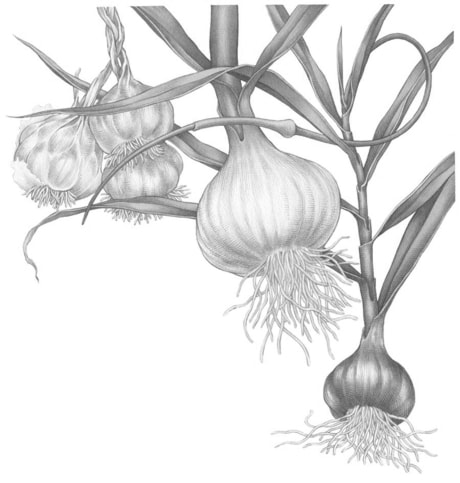If there was a magic bullet in herbal medicine, it would be garlic (Allium sativa).
Here’s a short history of the herb.
Remains of garlic have been found in caves which were inhabited by human beings more than 10,000 years ago. The first recorded use of garlic as medicine was found on a 3,000 year old Sumerian tablet.
There are more than 22 uses of garlic recorded in ancient Egyptian medical texts dating from 1500 B.C. The early Olympian athletes munched on garlic before a big race to enhance their strength and stamina. The ancient Ayurvedic medicine of India rubbed garlic salves over the putrefying wounds of leprosy.
What does modern clinical research say about this ancient herb? In laboratories, it has been found that six medium-size cloves of garlic pack the same anti-bacterial punch as 600,000 units of penicillin. That’s a lot of garlic to chew and swallow.
The ancient Egyptians ate at least six cloves a day to maintain good health. It is not without cause that ancient Greeks called them “The Stinking Ones”.
That is the problem with garlic: it’s medicine stinks. Garlic’s amazing anti-bacteria properties are attributed to a volatile oil called allicin. A whole clove of garlic, however does not contain any allicin. It is not until the clove is crushed, chewed, bruised or chopped that the medicinal allicin materializes due to the interaction between a volatile oil called alliin and enzymes called allinase. Allicin stinks.
The other important fact about the garlic is, if sautéed, the medicine is lost. Volatile oils are called volatile because when they come into contact with heat, they vapourize. In other words, supper smells good, but the medicine has vanished into thin air.
To get the medicinal benefit of garlic, I recommend stirring it into the pot of spaghetti sauce or stew just before serving the meal. This way, most of the garlic’s medicine mingles with the other flavours in the pot and raw garlic’s biting pungency is diminished.
Or, crush a couple of cloves into a blend of oil and vinegar and sprinkle it on salads. Both methods of taking fresh garlic fall short of the prescribed six cloves, but it will act as preventative medicine.
The garlic salad dressing is reminiscent of a traditional anti-plague formula from the 1700s. When the plague struck French cities, criminals awaiting execution were sent to bury the bodies of the fallen. The story goes that before going out into the plague ridden city, the criminals drank a vile concoction of apple cider vinegar and garlic to avoid succumbing to the Black Death. The formula became known as the Four Thieves.
The criminals became folk hero, for not only did they bury the dead, they also robbed them, becoming rich and surviving to tell the story. Doctor Christopher enhanced the formula by adding cayenne pepper (Capsicum minimum).
Eating garlic daily does not only prevent bacterial infections, it also decreases one’s chances of developing some types of cancer.
Studies in China, the Netherlands and U.S. involving more then 160,000 people have shown that being a garlic lover can significantly reduces the risk developing stomach and colon cancer. The researchers suggest it is due to allicin’s potent anti-oxidant effect.
That is not all garlic does:
It helps balance blood sugars in Type 2 diabetes.
Garlic lowers cholesterol levels. In one study volunteers were given six ounces of butter to eat. Half the volunteers were then given nine cloves of garlic to chew on. (Who signs up for these studies?) The ones who took the garlic had cholesterol levels seven per cent lower than before eating the butter. The cholesterol levels of those who only ate the butter were seven per cent higher.
Garlic kills off Helicobacter pylori. This is the bacteria associated with stomach ulcers.
Combine garlic with licorice root (Glycyrrhiza glabra) and one not only prevents but also heals stomach ulcers.
Garlic is the best home remedy for yeast infections. Many women swear by garlic to stop the discomfort and irritation in its tracks.
Remember what the garlic loving Hippocrates said, “Make food your medicine.” My philosophy is, feed garlic to everyone and no one complains of the smell.
Herbs for Life is written by Abrah Arneson, a local clinical herbalist. It is intended for information purposes only. Readers with a specific medical problem should consult a doctor. For more information, visit www.abraherbalist.ca. Arneson can be reached at abrah@shaw.ca.
